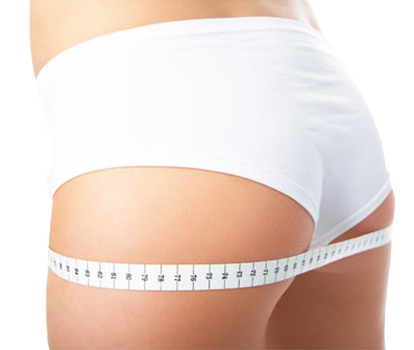Fat transfer in Tunisia
Several defects of the human body cause a certain discomfort and create a disharmonious aspect for the body. Fortunately a correction of the shortcomings of body’s lack of volume in some parts is possible thanks to lipofilling.
Fat transfer is a cosmetic surgery procedure that involves removing the patient's own fat and injecting it into the desired area. The advantage of this remodeling response is that the autograft is totally tolerated by the patient's body.
Fat transfer in Tunisia can involve several areas of the human body:
- Face fat transfer: to fill the wrinkles and restore volume to the face.
- Breast augmentation fat transfer: to increase the breast size by fat grafting.
- Buttock fat transfer: to increase and reshape the buttocks’ volume.
- Hips fat transfer: to increase hips.
- Calves Lipofilling: to increase the volume of the calves or correct hypoplasia.
- Hands fat transfer.
Also called lipostructure lipofilling of intervention is used to reshape the appearance of body parts to make them more attractive and harmonious.
Dr. Chiraz Bouzguenda propose lipofilling in Tunisia, enjoying a quiet and relaxing, very reasonable and affordable prices compared to France or Switzerland prices ...
You can now fill out the quote request available on our website.
The English word "lipofilling" means translation by the "filling with fat."
The objective of this technique of lipofilling or lipostructure is to inject the patient's own fat to fill depressions or volume loss. This technique consists in real autologous fat cells by the reinjection of the fat from the patient himself.
The reliability of this technique has enjoyed significant development since the onset of Dr. S. Coleman’s technique: gentle removal of fat technique and fat and fat centrifugation before reinjection technique.

The lipofilling technique is used for cosmetic surgery and restorations.
It is worth mentioning that about 30 % to 40 % of the injected fat can be reabsorbed. This is why a second session of lipofilling is to consider after 6 months to 1 year, if, of course, the patient wishes for optimal results.
Lipofilling can be specified as well be a part of facial cosmetic surgery, for the body, the face or as part of reconstructive surgery.
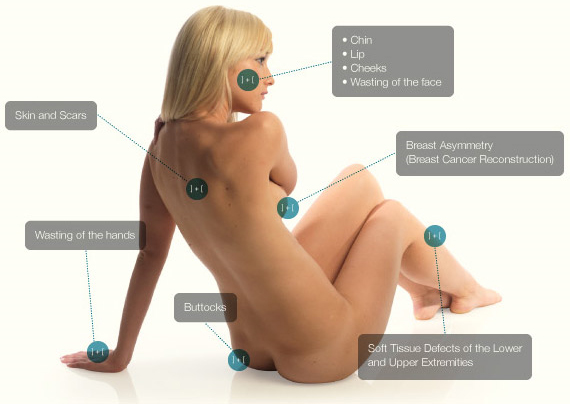
- Fill and reduce some wrinkles, especially on the face,
- Restore the "fullness" of a gaunt face or in the early stages of facial aging.
- Restore the face’s shape and volumes: we speak of the restoration of a face emaciated by aging.
- Improve facial harmony, often in addition to face and neck lift.
- Increase the volume of the breasts, calves or buttocks by lipofilling.
- Reconstruction after breast cancer: improving the contours of a breast reconstruction or sequel of breast conserving therapy, or a complete breast reconstruction.
- Bridging sequels of trauma or malformation or surgery depressions.
- Correct deficiencies caused by a poorly done liposuction.
- Correct high fat font, sequel of an HIV + patients.
As with any surgery, lipofilling requires a preoperative blood test.
Among the medical guidelines to follow:
- Tobacco, although it is not forbidden, should be stopped at least one month before the intervention because it undermines the proper healing.
- A ban on any product containing aspirin is mandatory for at least 10 days before the lipofilling.
- Type of anesthesia :
As with any surgery, lipostructure generally requires the completion of a classic general anesthesia. It is possible to do, in some cases, a soft local anesthesia or a deep local anesthesia. - Terms of hospitalization
Facial Lipofilling is usually done as an outpatient. Lipofilling breasts, buttocks or calves require hospitalization for 1-2 nights in clinic (depending on the amount of fat sucked).
Every surgeon performs the lipofilling with the technique he deems appropriate in order to obtaining the best result for each case he deals with.
However, there are principles to follow. After making the determination of fat donor areas and areas for fat reinjection, there are 3 operating times:
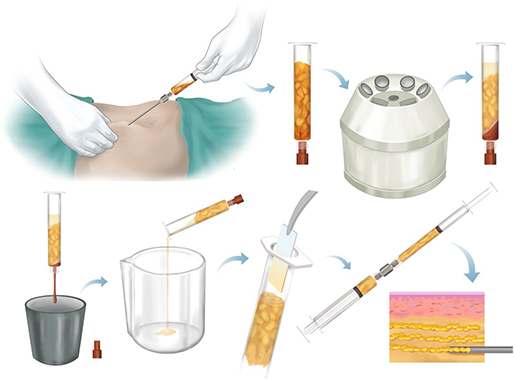
- The fat collecting process, is a real liposuction which gets done in a gentle and none traumatic way. It is made with small cannulas and through small and fine minimal incisions.
- The chosen sampling spots are discrete and have a reserve or even an excess of fat tissue.
Then, following the method of Coleman, the fat collected is processed by centrifugation, washed and filtered, separating the intact fat cells to be grafted, from the rest of the elements that will not be grafted (oil, serum).
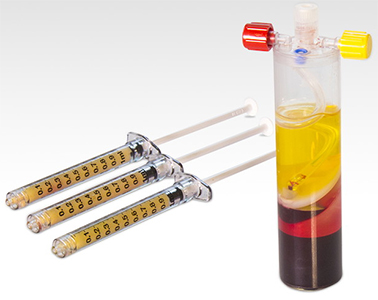
The injection of the fat takes place through a very small, micro-incision (1 to 2 mm) with micro- cannulas.
Injecting fat occurs on multiple planes and on several trips to increase the contact area between the transplanted cells and recipients implanted tissue, which contribute to a better engraftment.
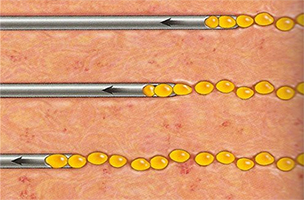
Insofar as they are true transplanted living cells, and provided that the technique is good with effective engraftment, the amount of injected fat varies depending on the space available and the needs of the patient (100 to 300cc or more). Lipostructure is a final and permanent technique since the grafted cells remain alive with tissue nearby.
The duration of the operation depends on the amount of fat aspirated and the number of sites to be treated. It takes about 30 minutes to 2 hours in case of an isolated lipostructure.
The lipofilling scars are very small and discreet: there are tiny scars on the fat donor areas of and even smaller, almost invisible scars (especially on the face) at the fat injected areas.
However, and as with all scars, they are final and final appearance can be enjoyed at 12 to 18 months.
You will feel a moderate pain during the first few days, especially in the treated areas. An analgesic prescript treatment will alleviate these discomforts.
It is quite common to see the formation of edema in the treated areas that will disappear in 1-3 months.
For ten days after surgery, bruising (bruises) may appear and then disappear in a natural way.
You might feel tiredness.
There should be a compression garment placed at the sampling areas.
You must also take 8 to 12 days of rest after the lipofilling intervention.
The return to normalcy and the resumption of sporting activities is possible at the end of the second month after the procedure.
In general, the final result of the lipofilling intervention is estimated obvious after 3 to 6 months after completion.
Complications in the lipofilling (lipostructure) are fortunately very rare. Patients are generally very satisfied with the results they get. However, be aware of the complications that are unpredictable and can occur even when the surgeon has all the skills required for the exercise of Plastic Surgery, Reconstructive and Aesthetic Surgery.
General complications :- The thromboembolism (phlebitis, pulmonary embolism).
- The infection is exceptional.
- A pneumothorax pleural breach is rare, but possible.
These are imperfections on the result:
- It is an excessive resorption of the grafted fat cells, which result in a low correction of the depression. This may need the procedure of a second fat injection, a few months following the procedure.
- Hypercorrection of the depression, much more difficult to fix, sometimes requiring SURGICAL resection or a micro-liposuction.
- Asymmetry in the results caused by an asymmetric resorption of the injected fat.
All In all, we must not overstate the risks, but just be aware that surgery, even seemingly simple, always has a small share of hazards.
Fat grafting abroad
- Procedure:The principle is to achieve a fat cells graft from the patient himself.
- Anesthesia :General or local.
- Operating Time: 1/2 hour to 2 hours.
- Length of Stay: In ambulatory or 1-2 nights.
- Length of stay overall: 4 to 7 days
- Recovery : 10 days
